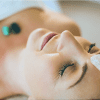
Great skin is not simply a matter of DNA — your daily habits, in fact, have a big impact on what you see in the mirror. But depending on which product reviews you read or doctors you consult, there is a dizzying number of opinions on everything; from how to moisturize to how to protect yourself from UV rays. Ultimately, caring for your skin is simply personal. Here’s what you should keep in mind to sort through all the noise:
WHERE TO BEGIN
Think of your skin-care routine as consisting of three main steps:
- Cleansing — Washing your face.
- Toning — Balancing the skin PH.
- Moisturizing — Hydrating and softening the skin.
The goal of any skin-care routine is to tune up your complexion so it’s functioning at its best, and also troubleshoot or target any areas you want to work on. As your skin needs shifts with age, so will your products. It’s not about creating perfection. Allow these three steps to become your daily ritual that fortifies your skin and grounds your day.
GIVE IT TIME
The science behind skin-care products has come a long way but there’s still no such thing as an instant fix — you need time to reap the benefits, results are only seen through consistent use. Generally, aim to use a product over at least six weeks, once or twice daily, to notice a difference.
Tip: With any skin-care product, apply in order of consistency — from thinnest to thickest. For example, cleanser, toner (if you use it), serum, and then moisturizer.
FIND YOUR CLEANSER
The right formula cleanses your skin without stripping essential, healthy oils. Take it easy with exfoliating scrubs (use once a week) and avoid those with crushed walnut shells or abrasive ingredients.
For everyday cleansing, here’s what to look for:
HOW TO USE TONER
For many, the word “toner” brings to mind stinging astringents from the ’80s. The original was an alcohol-based product that was used to dry up oily skin and remove any leftover dirt following cleansing. Today’s formulas, however, have evolved. Think of them as supplements — these thin liquids deliver an extra shot of nutrients, helping the other products in your regimen absorb better, while still balancing your complexion. Most experts consider toner to be optional. It can be a good way to add in specific ingredients that you may not have in your other products or add another layer of skin-replenishment. If you have the time and inclination, here are some hero ingredients to look for:
- Alpha and beta hydroxy acids to gently remove dead skin cells that can clog pores, improve sun-damaged skin, and minimize dullness.
- Hyaluronic acid to boost hydration, seal in dewiness, and plump skin to subtly treat fine lines.
- Rose water and green tea to calm irritation and reduce redness with an anti-inflammatory effect.
- Vitamin E and C to fight daily exposure to free radicals that can age your skin.
Toners should be done after cleansing and before putting on anything else. The traditional application method is to saturate a cotton pad and pass it over your face.
Tip: Applying toner with clean hands is the most efficient. Just pour a few drops in your palm, then swipe it on. Or if you prefer, you can pull apart a cotton pad so it’s not so thick before putting toner on it.
Most formulas can be used morning and night, but you might want to use those with exfoliating acids only at night or every other day.
MOISTURIZING
The most basic function of a moisturizer is to hydrate and soften the skin. Essentially, moisturizers assist in preventing water loss through the outer layers of skin. They can also complement the naturally found protective oils and other building blocks within the skin, such as ceramides. This is one product that doctors recommend using year-round, for all skin types. Skin naturally loses the ability to retain moisture as we age and daily activities, such as washing, can strip natural hydrators from the surface. Everyone needs moisture, but the texture of your moisturizer will differ depending on your skin type.
DAY vs. NIGHT CREAMS
Creams you apply in the morning are equipped to protect your skin from the environmental aggressors you’ll face when you leave the house—many contain antioxidants to minimize pollution-based free radicals and sunscreen to shield you from ultraviolet radiation. They typically have a lightweight consistency. Night creams, on the other hand, focus on repairing any damage you might have picked up with ingredients like retinol to speed cellular turnover and counteract dark spots. These creams also replenish moisture levels, which naturally dip in the evening, with emollients that often create a rich, thick texture.
EYE CREAMS EXPLAINED
Can you survive without an eye cream? Absolutely. But, if you have specific concerns — like hyperpigmentation, dryness or puffiness — you might want to try one. The skin around the eyes is quite thin and delicate, and more likely to react to irritating ingredients than other areas. Therefore, skin care professionals typically recommend an eye cream that considers the potential sensitivity and has more tolerable concentrations of active ingredients.
For under-eye bags and inflammation, caffeine, peptides and hyaluronic acid can be soothing. Dark circles can be due to visible veins or actual discoloration common in darker skin tones. Look for brightening ingredients like vitamin C, kojic acid and niacinamide.
Tip: Steer clear of strong retinols (which can sting and create redness) and fragrance, to avoid any eye irritation.




